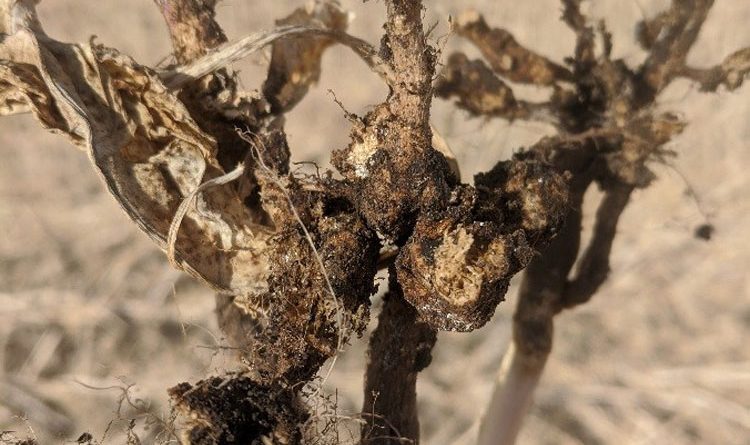Clubroot found in Wheatland County
By Sean Feagan, Local Journalism Initiative Reporter

Photo Courtesy of Russel Muenchrath
Some local farmers may want to consider new approaches to their crop rotation, as clubroot has been identified in Wheatland County.
Clubroot, a plant disease caused by the soil-borne microorganism, Plasmodiophora brassicae, affects plants in the cabbage family, including canola and mustard. The disease results in root galls, reducing plant health, vigour and, ultimately, yields for producers.
Wheatland County conducts annual clubroot surveys. But it was a research team from the University of Alberta that first confirmed the presence of the pathogen in a single infected field. After being notified of the discovery, the county ramped up surveys in the area and found an additional infected field, explained Russell Muenchrath, Wheatland County agricultural manager.
Each of the landowners on whose land the pathogen was found were issued notices limiting the growing of canola and mustard for at least four years, meaning they can now only grow a one in four rotation for those crops, explained Muenchrath. The notice also requires that once the producer returns to growing canola, they must plant a resistant variety. These notices are established under the provincial Agricultural Pests Act.
Management guidelines were discussed with each affected landowner. The county is recommending producers scout for signs of the disease, manage weeds belonging to the affected family, and sanitize and wash equipment between fields. Adjacent landowners and any other relevant parties, such as energy companies with leases on affected properties, were also notified.
Despite these new restrictions, the producers have been understanding, said Muenchrath.
“They’re farmers, they understand the implications of the disease and what they need to do from a management standpoint,” he said.
The county will likely increase the number of field inspections it performs next year to better understand the spread of the disease. “This was our first confirmed case, but that doesn’t mean it hasn’t been here for longer.”
While clubroot can cause complications, producers should not worry, noted Matt Gosling, agrologist and founder of Premium Ag Services Ltd. “It’s a completely manageable problem,” he said. “You have a rotation that spreads canola out in it and use genetics that have the capacity to deal with it. It’s not bad news; it’s inevitable news.”
Some of the management recommendations to control clubroot are not feasible for producers, added Gosling.
“I don’t know a single farmer that is going to clean their drill from field to field,” he said.
Selecting clubroot-resistant canola varieties is becoming easier too, as they are becoming more prevalent in the market. “I think in two or three years there probably won’t be any canola varieties out there that don’t come with some level of clubroot resistance or tolerance in their genetic package.”
Spreading canola in a rotation, as required by each notice, makes a big difference.
“A two-year break in between your canola reduces the spore load by well over 95 per cent; the longer, the better,” said Gosling.
For a one-in-four rotation, he recommends a pea-wheat-canola-barley rotation. “There’s a lot of good agronomic functionality to that rotation,” he said.
But complicating this approach is another plant pathogen, Aphanomyces, a water mould, which infects peas and lentils and causes root rot, he explained. As Canada’s pulse industry has gained traction over the last 15 or 20 years, so too has Aphanomyces.
There are no Aphanomyces-resistant varieties of peas and lentils available as yet. But there are commercial peas projected to hit the market in 2025 that have some level of tolerance, noted Gosling.
Aphanomyces is in some ways like the pathogen causing clubroot. “They both like water,” said Gosling. A pea or lentil crop could be fine one year when conditions are dry, but harbour the disease in a later wet year, resulting in a ruined crop and propagation of the pathogen’s spores.
Compared to Plasmodiophora, Aphanomyces spores have a longer lifespan, lasting about six years in soil. “That’s why clubroot is easier to manage, because after three years without a host, its population drastically reduces to the point where you can seed canola back in there,” said Gosling.
There are approaches to manage Aphanomyces, including field tests for the pathogen and a treatment to get rid of it. But a longer rotation is one of the best approaches to minimize the risk of the disease.
“My common practice is peas are just a one-in-six crop now,” he said. “I don’t want to start help managing a farm and recommend a one-in-four, because in five years, we might have to take two years completely off peas or lentils; that doesn’t really work.”
